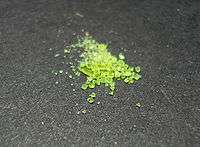Uranyl acetate
 | |
 Structure of dihydrate | |
| Names | |
|---|---|
| IUPAC name
Uranium bis((acetato)-O)dioxo-dihydrate | |
| Other names
Uranyl ethanoate ; Uranyl acetate dihydrate | |
| Identifiers | |
| 541-09-3 (anhydrous) 6159-44-0 (dihydrate) | |
| ECHA InfoCard | 100.007.971 |
| Properties | |
| UO2(CH3COO)2 (anhydrous) UO2(CH3COO)2·2H2O (dihydrate) | |
| Molar mass | 424.146 g/mol (dihydrate) |
| Appearance | yellow-green crystals (dihydrate) |
| Density | 2.89 g/cm3 (dihydrate) |
| Melting point | decomposes at 80 °C (dihydrate) |
| Solubility | slightly soluble in ethanol[1] |
| Except where otherwise noted, data are given for materials in their standard state (at 25 °C [77 °F], 100 kPa). | |
| | |
| Infobox references | |
Uranyl acetate (UO2(CH3COO)2·2H2O) is the acetate salt of uranyl and is a yellow-green crystalline solid made up of yellow-green rhombic crystals and has a slight acetic odor. This compound is a nuclear fuel derivative, and its use and possession are sanctioned by international law.
Production
Commercial preparations of uranyl acetate are usually made from depleted uranium and are prepared by reacting metallic uranium with acetic acid.
Uses
Uranyl acetate is extensively used as a negative stain in electron microscopy.[2] Most procedures in electron microscopy for biology require the use of uranyl acetate. Negative staining protocols typically treat the sample with 1% to 5% aqueous solution. Uranyl acetate staining is simple and quick to perform and one can examine the sample within a few minutes after staining. Some biological samples are not amenable to uranyl acetate staining and, in these cases, alternative staining techniques and or low-voltage electron microscopy technique may be more suitable.
1% and 2% uranyl acetate solutions are used as an indicator, and a titrant in stronger concentrations in analytical chemistry, as it forms an insoluble salt with sodium (the vast majority of sodium salts are water-soluble). Uranyl acetate solutions show evidence of being sensitive to light, especially UV, and will precipitate if exposed.
Uranyl acetate is also used in a standard test—American Association of State Highway and Transportation Officials (AASHTO) Designation T 299—for alkali-silica reactivity in aggregates (crushed stone or gravel) being considered for use in cement concrete.
Uranyl acetate dihydrate has been used as a starting reagent in experimental inorganic chemistry, for example, [UO2Cl2(THF)2] (THF = tetrahydrofuran).[3]
Safety
Uranyl acetate is both radioactive and toxic. Normal commercial stocks prepared from depleted uranium have a typical specific activity of 0.37–0.51 microcuries (14–19 kBq) per gram. This is a very mild level of radioactivity and is not sufficient to be harmful while the material remains external to the body.
Uranyl acetate is very toxic if ingested, inhaled as dust or by skin contact if skin is cut or abraded. The toxicity is due to the combined effect of chemical toxicity and mild radioactivity and there is a danger of cumulative effects from long term exposure.
References
- ↑ Lide, David R. (1998), Handbook of Chemistry and Physics (87 ed.), Boca Raton, FL: CRC Press, pp. 3–566, ISBN 0-8493-0594-2
- ↑ "Negative Staining" University of Oxford
- ↑ Uranyl polyhalides. Molecular structure of [UO2(OAsPh3)4](Br3)2] and [UO2(OPPh3)4](I3)2], Polyhedron, 2002, 21, 2755
External links
| Salts and the ester of the acetate ion | |||||||||||||||||||
|---|---|---|---|---|---|---|---|---|---|---|---|---|---|---|---|---|---|---|---|
| AcOH | He | ||||||||||||||||||
| LiOAc | Be(OAc)2 BeAcOH |
B(OAc)3 | ROAc | NH4OAc | AcOAc | FAc | Ne | ||||||||||||
| NaOAc | Mg(OAc)2 | Al(OAc)3 ALSOL Al(OAc)2OH Al2SO4(OAc)4 |
Si | P | S | ClAc | Ar | ||||||||||||
| KOAc | Ca(OAc)2 | Sc(OAc)3 | Ti(OAc)4 | VO(OAc)3 | Cr(OAc)2 | Mn(OAc)2 Mn(OAc)3 |
Fe(OAc)2 Fe(OAc)3 |
Co(OAc)2, Co(OAc)3 |
Ni(OAc)2 | Cu(OAc)2 | Zn(OAc)2 | Ga(OAc)3 | Ge | As(OAc)3 | Se | BrAc | Kr | ||
| RbOAc | Sr(OAc)2 | Y(OAc)3 | Zr(OAc)4 | Nb | Mo(OAc)2 | Tc | Ru(OAc)2 Ru(OAc)3 Ru(OAc)4 |
Rh2(OAc)4 | Pd(OAc)2 | AgOAc | Cd(OAc)2 | In | Sn(OAc)2 Sn(OAc)4 |
Sb(OAc)3 | Te | IAc | Xe | ||
| CsOAc | Ba(OAc)2 | Hf | Ta | W | Re | Os | Ir | Pt(OAc)2 | Au | Hg2(OAc)2, Hg(OAc)2 |
TlOAc Tl(OAc)3 |
Pb(OAc)2 Pb(OAc)4 |
Bi(OAc)3 | Po | At | Rn | |||
| Fr | Ra | Rf | Db | Sg | Bh | Hs | Mt | Ds | Rg | Cn | Nh | Fl | Mc | Lv | Ts | Og | |||
| ↓ | |||||||||||||||||||
| La(OAc)3 | Ce(OAc)x | Pr | Nd | Pm | Sm(OAc)3 | Eu(OAc)3 | Gd(OAc)3 | Tb | Dy(OAc)3 | Ho(OAc)3 | Er | Tm | Yb(OAc)3 | Lu(OAc)3 | |||||
| Ac | Th | Pa | UO2(OAc)2 | Np | Pu | Am | Cm | Bk | Cf | Es | Fm | Md | No | Lr | |||||